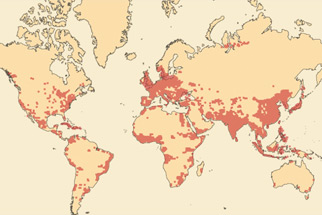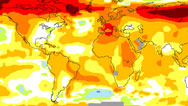Human Numbers Through Time
- By Susan K. Lewis
- Posted 04.20.04
- NOVA
For most of human existence our ancestors led precarious lives as scavengers, hunters, and gatherers, and there were fewer than 10 million human beings on Earth at any one time. Today, many cities have more than 10 million inhabitants each, and populations continue to skyrocket. Trace the dramatic growth of human populations over recent centuries on our global map, and see where on Earth as many as three billion more people may live by 2050.
 Launch Interactive
Printable Version
Launch Interactive
Printable Version
Examine global population growth over the past two millennia, and see what's coming in the next 50 years.
Note on Graphics
The global map was adapted from World Population: A Graphic Simulation of the History of Human Population Growth, a 2003 video produced by Population Connection (www.populationconnection.org). In the map, each dot represents a million people. In areas where populations are widely dispersed, dots are placed in the middle of an approximate range.
When areas become super-populated, as they begin to do in certain parts of the world in the 20th century, the dots merge and spread outward like a stain. As a result, some dots may appear in places that are not in reality densely inhabited; even countries or regions that appear "filled up" in later maps may still have sparsely populated regions.
Sources for the graph entitled "World Population Growth, 1800-2050," which appears at the end of the series, are the United Nations, World Population Prospects, The 2003 Revision, and estimates by the Population Reference Bureau (www.prb.org).
Credits
Illustrations
- (all)
- © WGBH/NOVA
Related Links
-

Be a Demographer
Play a matching game to see how demographic data will shape the future of the U.S., Japan, Kenya, and India.
-

The Global Population Conundrum
Worldwatch founder Lester Brown marshals sobering figures in this discussion of the likely impact of population growth.
-

Earth in Peril
How do consumption and rapid population growth affect our planet's natural resources?
-

Population Campaigns
Compare how three developing nations have tried to slow rapid population growth.
You need the Flash Player plug-in to view this content.

